Dear Zazie, Here is today’s Lovers’ Chronicle from Mac Tag. What remains for you? Rhett
The Lovers’ Chronicle
Dear Muse,
this remains, summed up, the sensations, in lookin’ at you, the romance, at a single glance enveloped by feelin’s, memories; in an instant, complete, through the senses, the tones, a unity possible where the words come one after the other and reunite the end with the beginnin’
© copyright 2021 mac tag/cowboy coleridge all rights reserved
© copyright 2020 mac tag/cowboy coleridge all rights reserved
never fergit…
some of us
are just not fit
for human
cohabitation
© copyright 2019 mac tag/cowboy coleridge all rights reserved
readin’ through
your old letters
it helps but then,
it does not
what is best
keep the pang close
or bury it
perhaps, time
to move on
to want
what cannot be
to wish for that
which cannot be
holdin’ the letter
you wrote to me in French
the scent of your perfume,
remains
bein’ without you,
remains
what else is there
what else remains
© copyright 2018 mac tag/cowboy coleridge all rights reserved
Another for the lack thereof. Of you, I have our words, my reveries and my deams. That is all that ……
Remains
For the past year,
Been readin’ through,
All the e-mails
we wrote to each other
Some were well remembered
Some, welcome surprises
As you no doubt surmised,
It became part of my routine
A cherished ritual
After checkin’ e-mail,
And right before
The Writer’s Almanac
Each day, opened
an email from that day,
from each year since we met
How good it’s been
to have your voice
inside my head
Today is the full circle point
The last one has been read
Had not thought of the day
When I would reach the end
Alas, now what?
Oh my, what now?
Start over and read them again?
It helps but then,
it does not help
Keep the pang close
or bury it?
Perhaps, time to move on?
To hold
that which cannot be held
To want
what cannot be wanted
To wish for that
which cannot be
Reached into my desk drawer
Pulled out the handwritten
note that you wrote
to me in French
Held it and stared
Read it again
The scent of your perfume,
remains
The pain of bein’ without you,
remains
What else is there?
What else remains?
© 2013 Mac Tag/Cowboy Coleridge All rights reserved
The Song of the Day is “Remains” by Maurissa Tancharoen and Jed Whedon Vocals by Maurissa Tancharoen Video written, directed, and shot by Anton King. We do not own the rights to this song. All rights reserved by the rightful owner. No copyright infringement intended.
Today is the birthday of Eugène Henri Paul Gauguin (Paris 7 June 1848 – 8 May 1903 Atuona, Marquesas Islands, French Polynesia); post-Impressionist artist. Underappreciated until after his death, Gauguin is now recognized for his experimental use of color and synthetist style that were distinctly different from Impressionism. His work was influential to the French avant-garde and many modern artists. He was an important figure in the Symbolist movement as a painter, sculptor, printmaker, ceramist, and writer. His bold experimentation with color led directly to the Synthetist style of modern art.
In 1873, he married a Danish woman, Mette-Sophie Gad (1850–1920). By 1884, Gauguin had moved with his family to Copenhagen, Denmark, where he pursued a business career as a tarpaulin salesman. It was not successful. His marriage fell apart after 11 years when Gauguin was driven to paint full-time. He returned to Paris in 1885, after his wife and her family asked him to leave because he had renounced the values they shared. Gauguin’s last physical contact with them was in 1891, Mette eventually breaking with him decisively in 1894.
Gauguin wrote a travelogue (first published 1901) titled Noa Noa, originally conceived as commentary on his paintings and describing his experiences in Tahiti. In it he revealed that he had at this time taken a thirteen-year-old girl as native wife or vahine (the Tahitian word for “woman”), a marriage contracted in the course of a single afternoon. This was Teha’amana, called Tehura in the travelogue, who was pregnant by him by the end of summer 1892. Teha’amana was the subject of several of Gauguin’s paintings, including Merahi metua no Tehamana and the celebrated Spirit of the Dead Watching, as well as a notable woodcarving Tehura now in the Musée d’Orsay.
-

The Market Gardens of Vaugirard, 1879, Smith College Museum of Art
-

Winter Landscape, 1879, Museum of Fine Arts, Budapest
-

Portrait of Madame Gauguin, c. 1880–81, Foundation E.G. Bührle, Zürich
-

Garden in Vaugirard (Painter’s Family in the Garden in Rue Carcel), 1881, Ny Carlsberg Glyptotek, Copenhagen
-

Women Bathing, 1885, National Museum of Western Art, Tokyo
-

La Bergère Bretonne, 1886, Laing Art Gallery
-
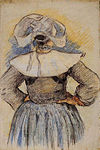
Breton Girl, 1886, Burrell Collection, Glasgow
-

Breton Bather, 1886, Art Institute of Chicago
-

The Yellow Christ (Le Christ jaune), 1889, Albright-Knox Art Gallery, Buffalo, NY.
-

Still Life with Profile of Laval, 1886, Indianapolis Museum of Art.
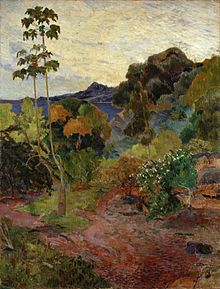
-

Huttes sous les arbres, 1887, Private collection, Washington
-

Bord de Mer II, 1887, Private collection, Paris
-

At the Pond, 1887, Van Gogh Museum, Amsterdam
-
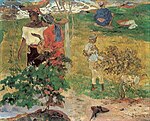
Conversation Tropiques (Négresses Causant), 1887, Private collection, Dallas
-

Among the Mangoes (La Cueillette des Fruits), 1887, Van Gogh Museum, Amsterdam[44]


-

Page from Gauguin’s notebook (date unknown), Ancien Culte Mahorie. Louvre
-

Te aa no areois (The Seed of the Areoi), 1892, Museum of Modern Art
-
Spirit of the Dead Watching 1892, Albright-Knox Art Gallery, Buffalo, NY

-

Nave nave moe (Sacred spring, sweet dreams), 1894, Hermitage Museum
-

Annah the Javanese, (1893), Private collection
-

Paul Gauguin, Alfons Mucha, Luděk Marold, and Annah the Javanese at Mucha’s studio, 1893
-

Nave Nave Fenua (Delightful Land), woodcut in Noa Noa series, 1894, Art Gallery of Ontario
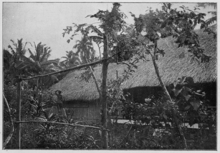

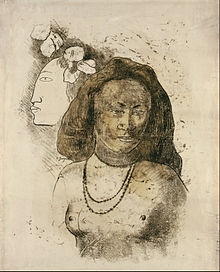
-

O Taiti (Nevermore), 1897, Courtauld Institute
-

Eve (The Nightmare), 1899–1900, monotype, J. Paul Getty Museum
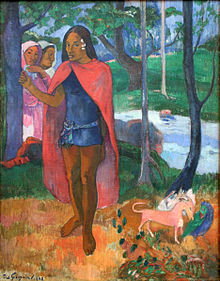


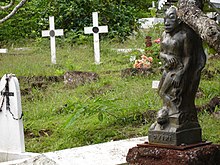
-

Cavaliers sur la Plage [II] (Riders on the Beach), 1902, Private collection
-

Landscape with a Pig and a Horse (Hiva Oa), 1903, Ateneum, Helsinki
-

Still life with Exotic Birds, 1902, Pushkin Museum
-

Jeune fille à l’éventail (Young Girl with a Fan), 1902, Museum Folkwang
-

Contes barbares (Primitive Tales), 1902, Museum Folkwang









-

Still-Life with Fruit and Lemons (c. 1880)
-

The Swineherd, Brittany (1888)
-
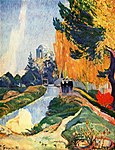
Les Alyscamps (1888)
-

Vision After the Sermon (Jacob wrestling with the angel) (1888)
-

Night Café at Arles, (Mme Ginoux) (1888)
-

Still Life with Japanese Woodcut (1889)
-

Tahitian Women on the Beach (1891)
-

Delightful Land (Te Nave Nave Fenua) (1892)
-

Arii Matamoe (The Royal End) (1892)
-

The Moon and the Earth (Hina tefatou) (1893)
-

Watermill in Pont-Aven (1894)
-
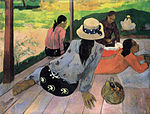
The Midday Nap (1894)
-

Maternity (1899)
-

Two Tahitian Women (1899)
-

Two Women (1901 or 1902)
-

Self-portrait, 1875–1877, Fogg Museum, Cambridge, Massachusetts
-

Self-portrait, 1885, Kimbell Art Museum, Fort Worth, Texas
-

Self-portrait, 1888, Van Gogh Museum, Amsterdam
-

Self-Portrait with Halo and Snake, 1889, National Gallery of Art, Washington, DC
-

Christ in the Garden of Olives (Gauguin’s self-portrait) 1889, Norton Museum of Art
-
Self-portrait, 1889–1890, Musée d’Orsay, Paris
-

Self-portrait, 1893, Musée d’Orsay
-

Self-portrait, c. 1893, Detroit Institute of Arts
-

Self-portrait, 1896, São Paulo Museum of Art
-

Self-portrait (for my friend Daniel), 1896, Musée d’Orsay
Je suis un grand artiste et je le sais. C’est parce que je le suis que j’ai tellement enduré de souffrances. Pour poursuivre ma voie, sinon je me considérerai comme un brigand. Ce que je suis du reste pour beaucoup de personnes. Enfin, qu’importe! Ce qui me chagrine le plus c’est moins la misère que les empêchements perpétuels à mon art que je ne puis faire comme je le sens et comme je pourais le faire sans la misère qui me lie les bras. Tu me dis que j’ai tort de rester éloigné du centre artistique. Non, j’ai raison, je sais depuis longtemps ce que je fais et pourquoi je le fais. Mon centre artistique est dans mon cerveau et pas ailleurs et je suis fort parce que je ne suis jamais dérouté par les autres et je fais ce qui est en moi.
- Letter to his wife, Mette (Tahiti, March 1892), pp. 53-54.
Comment voyez-vous cet arbre? Il est bien vert? Mettez donc du vert, le plus beau vert de votre palette; — et cette ombre, plutôt bleue? Ne craignez pas la peindre aussi bleue que possible.
La peinture est le plus beau de tous les arts; en lui se résument toutes les sensations, à son aspect chacun peut, au gré de son imagination, créer le roman, d’un seul coup d’œil avoir l’âme envahie par les plus profonds souvenirs; point d’effort de mémoire, tout résumé en un seul instant. — Art complet qui résume tous les autres et les complète. — Comme la musique, il agit sur l’âme par l’intermédiaire des sens, les tons harmonieux correspondant aux harmonies des sons; mais en peinture on obtient une unité impossible en musique où les accords viennent les uns après les autres, et le jugement éprouve alors une fatigue incessante s’il veut réunir la fin au commencement. En somme, l’oreille est un sens inférieur à celui de l’œil. L’ouïe ne peut servir qu’à un seul son à la fois, tandis que la vue embrasse tout, en même temps qu’à son gré elle simplifie.
Today is the birthday of Gwendolyn Elizabeth Brooks (Topeka, Kansas; June 7, 1917 – December 3, 2000 Chicago); poet and teacher. She was the first African-American woman to win a Pulitzer prize when she was awarded the Pulitzer Prize for Poetry in 1950 for her second collection, Annie Allen.
It is brave to be involved
To be not fearful to be unresolved.
- “do not be afraid of no” from Annie Allen (1949)
- Exhaust the little moment.
Soon it dies.
And be it gash or gold it will not come
Again in this identical guise.- “exhaust the little moment” from Annie Allen (1949)
Art hurts. Art urges voyages—
and it is easier to stay at home.
- “The Chicago Picasso” (1968)
To be in love
Is to touch with a lighter hand.
In yourself you stretch, you are well.
- “To Be In Love”
- He is not there but
You know you are tasting together
The winter, or a light spring weather.
His hand to take your hand is
overmuch.
Too much too bear.- “To Be In Love”
Come: there shall be such islanding from grief,
And small communion with the master shore.
Twang they. And I incline this ear to tin,
Consult a dual dilemma. Whether to dry
In humming pallor or to leap and die.
A Sunset of the City
Mac Tag
Follow us on twitter @cowboycoleridge

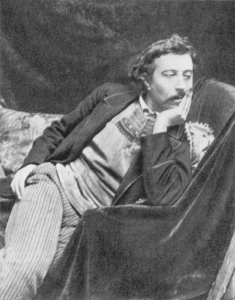


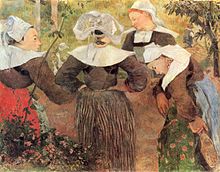

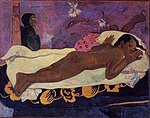
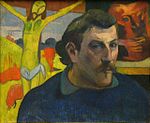
No Comments on "The Lovers’ Chronicle 7 June – remains, first reprise – art by Paul Gauguin – verse by Gwendolyn Brooks"